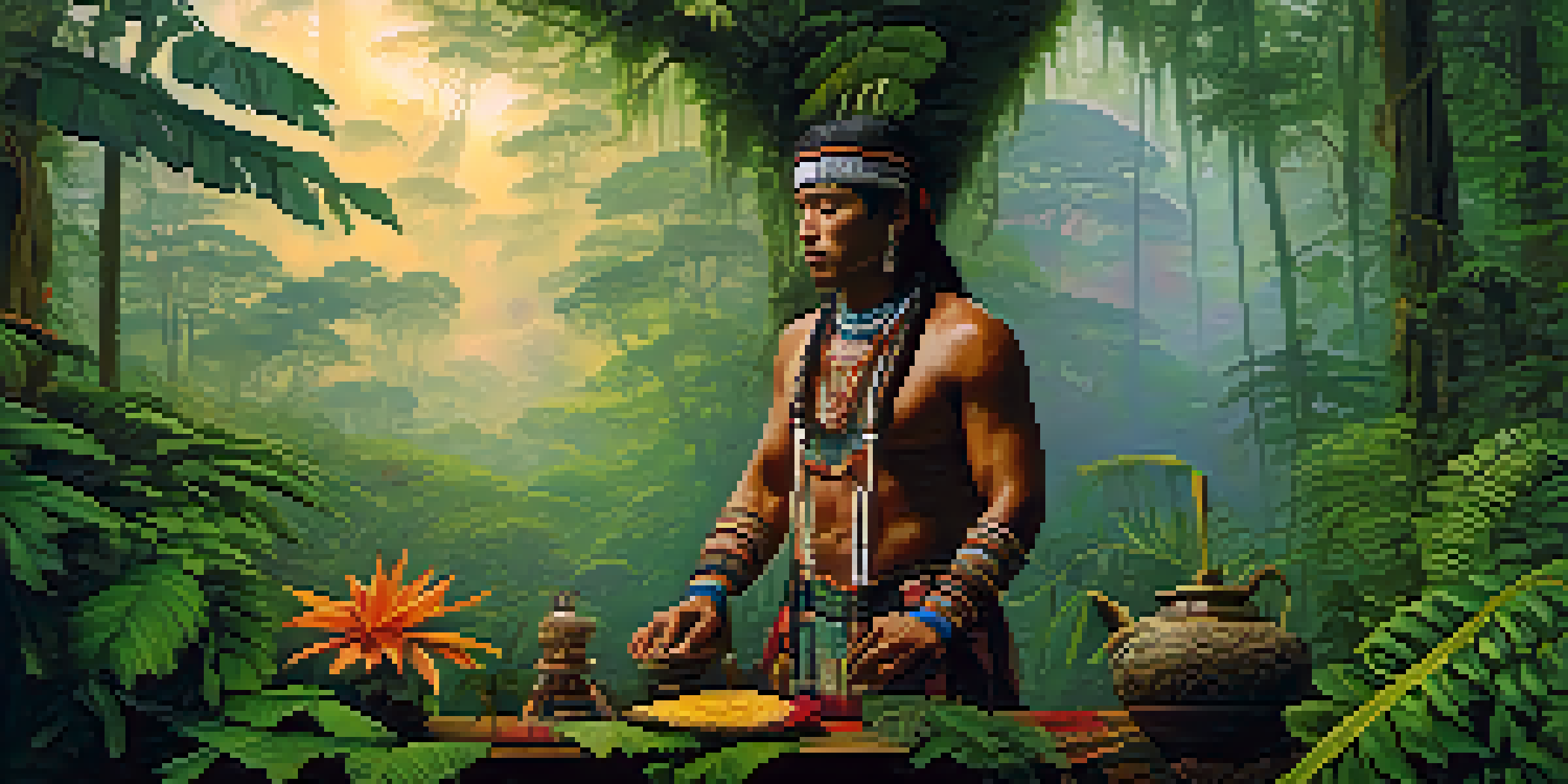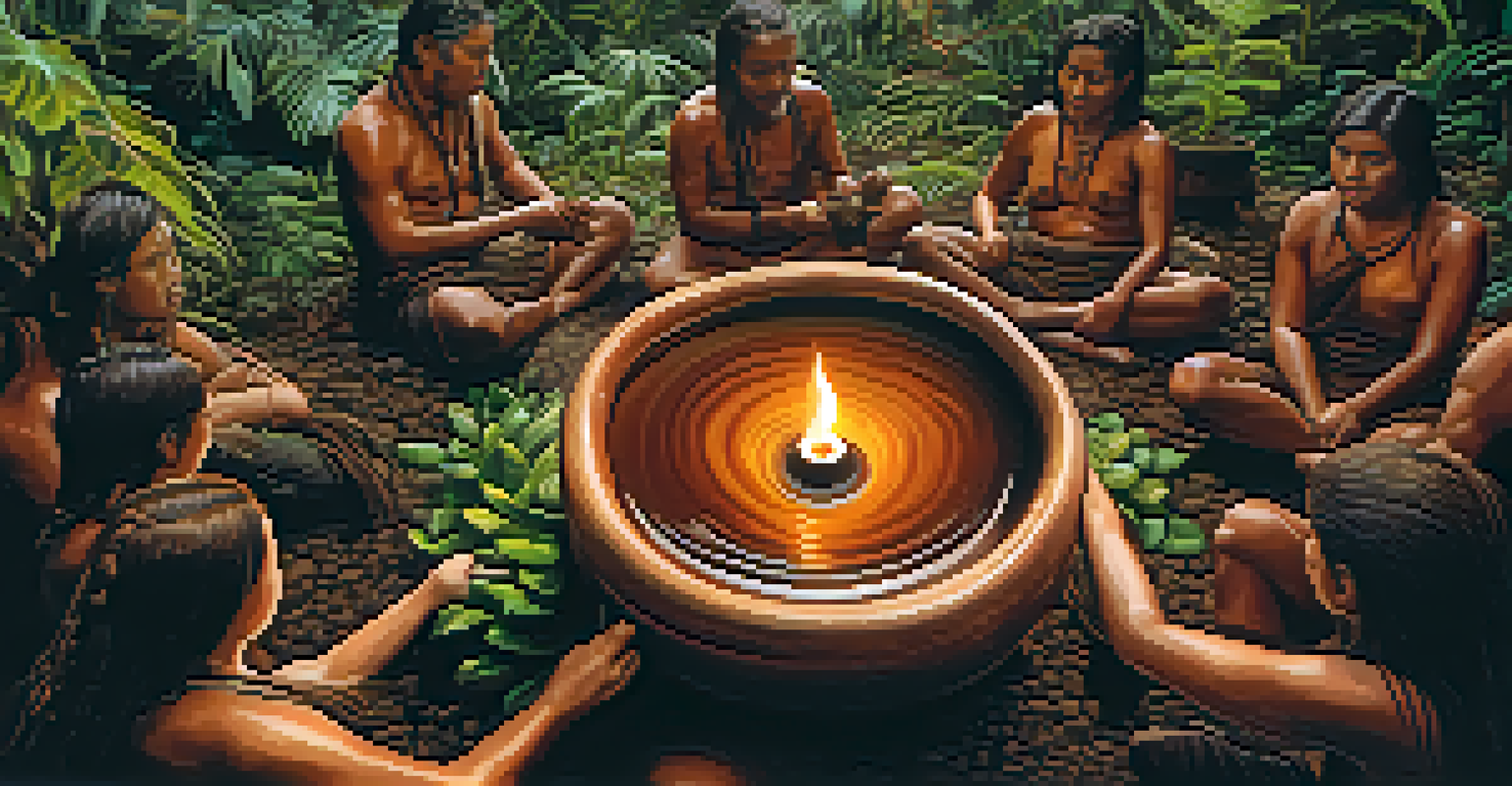Ayahuasca Rituals: Insights from Indigenous Leaders

Understanding Ayahuasca: A Journey Through Tradition
Ayahuasca is a sacred brew made from the Banisteriopsis caapi vine and other plants, traditionally used by indigenous tribes in the Amazon. This powerful concoction is known for its psychoactive properties, guiding participants on deep spiritual journeys. Understanding Ayahuasca is crucial, as it embodies the cultural practices and beliefs of the communities that have used it for centuries.
Ayahuasca is a tool for healing and insight that connects us to the spirit of the plant and the community.
Indigenous leaders emphasize that Ayahuasca is much more than a mere hallucinogen; it’s a tool for healing and insight. During rituals, the brew is consumed under the guidance of a shaman, who facilitates the experience. This relationship between the leader and participants is fundamental, as it helps to create a safe and supportive environment.
Furthermore, the rituals surrounding Ayahuasca are steeped in tradition, often integrating music, chanting, and other spiritual practices. These elements enhance the experience, allowing participants to connect not just with themselves, but with the spirit of the plant and the community. In this way, Ayahuasca becomes a shared journey of discovery and healing.
The Role of Indigenous Leaders in Ayahuasca Ceremonies
Indigenous leaders, often referred to as shamans or curanderos, play a pivotal role in Ayahuasca ceremonies. They are not only guides but also custodians of ancient knowledge and traditions. Their expertise comes from years of training and experience, which allows them to navigate the complexities of the Ayahuasca experience.

These leaders prepare the brew and conduct the rituals, creating a space for participants to explore their inner worlds. Their presence is vital, as they can interpret visions and provide support during challenging moments. This guidance is essential, as navigating the emotional depths of an Ayahuasca journey can be overwhelming without proper support.
Ayahuasca as a Healing Journey
Ayahuasca serves as a powerful tool for healing and spiritual insight, guided by indigenous leaders who create a supportive environment for participants.
Moreover, indigenous leaders often emphasize the importance of intention-setting before the ceremony. Participants are encouraged to reflect on what they hope to gain from the experience, which helps to focus the journey. This practice not only enhances individual experiences but also aligns the collective energy of the group, creating a more powerful ceremonial atmosphere.
Cultural Significance of Ayahuasca in Indigenous Communities
For many indigenous communities, Ayahuasca is deeply interwoven into their cultural fabric. It serves various purposes, from healing physical ailments to fostering community bonds and spiritual growth. The rituals associated with Ayahuasca are often seen as rites of passage, marking significant life transitions.
The journey through Ayahuasca rituals is not just about personal healing; it's about embracing a holistic approach that honors the past while looking to the future.
Indigenous leaders often share stories that highlight the communal aspect of Ayahuasca rituals. These stories reinforce the idea that healing and growth are collective experiences. Participants come together to support one another, creating a sense of unity that extends beyond the ceremony itself.
Additionally, the use of Ayahuasca is often linked to a broader worldview that respects nature and the interconnectedness of all life. This perspective fosters a deep sense of responsibility towards the environment, encouraging sustainable practices within the community. The rituals not only honor the past but also guide future generations in their relationship with the earth.
Healing Through Ayahuasca: Personal Transformations
Many participants report profound personal transformations after undergoing Ayahuasca rituals. These experiences often reveal deep-seated emotions or traumas, allowing individuals to confront and process them in a supportive environment. This therapeutic aspect of Ayahuasca is one of the reasons for its growing popularity worldwide.
Indigenous leaders highlight the importance of integration after the ceremony. Participants are encouraged to reflect on their experiences and apply the insights gained to their daily lives. This process is crucial for ensuring that the healing benefits of Ayahuasca are not lost once the ceremony ends.
Cultural Context is Crucial
The rituals surrounding Ayahuasca are steeped in tradition, emphasizing community, respect for nature, and the interconnectedness of life.
Furthermore, sharing these transformations within the community strengthens bonds and encourages others to embark on their healing journeys. The collective sharing of experiences helps normalize discussions around mental health and emotional well-being, making healing a communal effort rather than an isolated one.
Navigating the Risks of Ayahuasca Use
While Ayahuasca can offer profound insights, it is essential to acknowledge the risks involved. Not everyone is suited for the experience, especially individuals with certain mental health conditions. Indigenous leaders often stress the importance of pre-screening participants to ensure their safety during the ceremony.
Moreover, the setting in which Ayahuasca is consumed plays a critical role in the overall experience. A safe, controlled environment, led by experienced practitioners, is vital to minimize potential adverse effects. This is why indigenous leaders take their responsibilities seriously, ensuring that participants are well-prepared for the journey ahead.
Additionally, participants are encouraged to conduct thorough research and choose reputable facilitators. This diligence can help avoid exploitation and ensure that the rituals are conducted with respect for the traditions and the plant. Being informed empowers individuals to make choices that align with their well-being.
The Global Interest in Ayahuasca: A Double-Edged Sword
The rising global interest in Ayahuasca has led to both positive and negative consequences for indigenous communities. On one hand, it has brought attention to their cultures and practices, fostering cross-cultural exchanges and understanding. This newfound interest can help preserve traditional knowledge and generate economic opportunities for these communities.
On the flip side, commercialization poses significant threats. Many indigenous leaders express concerns about the exploitation of their sacred traditions by outsiders seeking profit. This has led to a proliferation of unregulated retreats and ceremonies, often lacking the cultural context and respect inherent to traditional practices.
Risks and Responsibilities
While Ayahuasca offers transformative experiences, it's essential to navigate its risks carefully, ensuring participants are well-prepared and supported.
To navigate this complex landscape, it’s crucial for participants to approach Ayahuasca with respect and humility. Engaging with indigenous leaders and supporting their initiatives can help ensure that the benefits of Ayahuasca rituals are shared ethically and sustainably. This approach fosters a deeper understanding and appreciation of the traditions that have been preserved for generations.
Embracing the Wisdom of Indigenous Leaders
Ultimately, the insights of indigenous leaders are invaluable in understanding the full scope of Ayahuasca rituals. Their teachings provide context, emphasizing the importance of respect, intention, and community. By listening to these leaders, participants can deepen their experiences and foster a more meaningful connection to the practice.
Engaging with indigenous leaders also supports the preservation of their cultures and knowledge systems. When participants honor these traditions, they contribute to the continuity of practices that have existed for centuries. This mutual respect enriches the experience for everyone involved.

In summary, the journey through Ayahuasca rituals is not just about personal healing; it's about embracing a holistic approach that honors the past while looking to the future. By valuing the wisdom of indigenous leaders, we can create a more respectful and connected experience that benefits both individuals and communities alike.